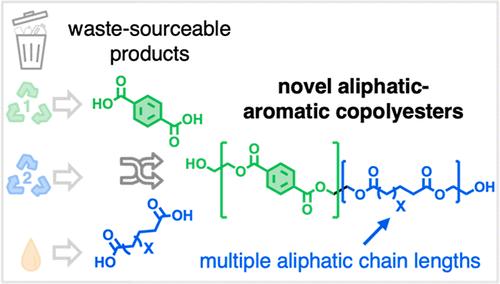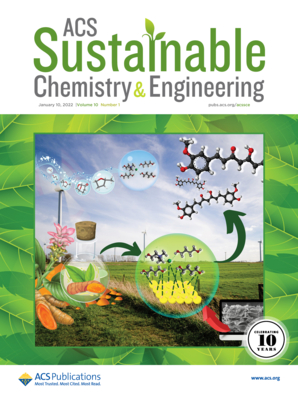Aliphatic–Aromatic Copolyesters with Waste-Sourceable Multiple Chain-Length Building Blocks
IF 7.1
1区 化学
Q1 CHEMISTRY, MULTIDISCIPLINARY
引用次数: 0
Abstract
Sourcing commodity polymers from sustainable alternative feedstocks, such as those derived from plastic waste or biobased resources, is a promising approach to alleviate the reliance on finite fossil fuel stocks for the production of virgin plastics. Linear aliphatic dicarboxylic acids of multiple chain lengths can be obtained from polyethylene (PE) waste, and their use in the synthesis of aliphatic polyesters has recently been demonstrated. To improve the materials’ properties of polyesters derived from multiple chain-length dicarboxylates, we herein combined this feedstock with terephthalate as an aromatic monomer unit to yield aliphatic–aromatic copolyesters. We established structure–property relationships for copolyesters derived from aliphatic dicarboxylates of multiple chain lengths (C4–C20) as a model for catalytic oxidation products of PE waste, or from 1,18-octadecanedioate as reference materials for polyesters from single, long chain length dicarboxylates. Thermal properties and solid-state structures were dominated by the ratio of aliphatic to aromatic monomer units rather than the identity of the aliphatic dicarboxylate or diol components. We demonstrated upscaling of the copolyester synthesis, as well as processability and mechanical properties of a multiple chain length copolyester, which showed comparable properties to the commercial polybutylene adipate-co-terephthalate. Finally, we showed an alternative production via catalytic transesterification and thus postmodification of premade polyesters, including postconsumer polyethylene terephthalate, as model waste sources.

求助全文
约1分钟内获得全文
求助全文
来源期刊

ACS Sustainable Chemistry & Engineering
CHEMISTRY, MULTIDISCIPLINARY-ENGINEERING, CHEMICAL
CiteScore
13.80
自引率
4.80%
发文量
1470
审稿时长
1.7 months
期刊介绍:
ACS Sustainable Chemistry & Engineering is a prestigious weekly peer-reviewed scientific journal published by the American Chemical Society. Dedicated to advancing the principles of green chemistry and green engineering, it covers a wide array of research topics including green chemistry, green engineering, biomass, alternative energy, and life cycle assessment.
The journal welcomes submissions in various formats, including Letters, Articles, Features, and Perspectives (Reviews), that address the challenges of sustainability in the chemical enterprise and contribute to the advancement of sustainable practices. Join us in shaping the future of sustainable chemistry and engineering.
 求助内容:
求助内容: 应助结果提醒方式:
应助结果提醒方式:


